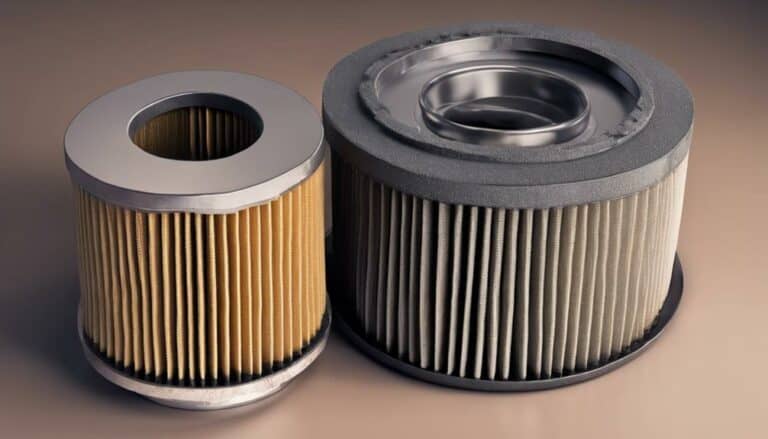So, you're out there tearing up the trails on your dirt bike, feeling the thrill of the ride. But have you considered the state of your air filter lately? Knowing when to replace it instead of just cleaning it can be a game-changer for your bike's performance.
But how do you really know when it's time to switch out that filter? Stay tuned to uncover the telltale signs that it might be more than just a cleaning job for your air filter.
Key Takeaways
- Inspect for dirt accumulation and damage to determine if replacement is necessary.
- Evaluate engine performance for signs like reduced power and increased fuel consumption.
- Consider manufacturer's guidelines and cleaning frequency when deciding between cleaning and replacement.
- Monitor exhaust gas color and power delivery for indicators of a dirty or damaged filter.
Signs of a Dirty Dirt Bike Air Filter
If you notice increased fuel consumption while riding your dirt bike, it could be a sign of a dirty air filter. A dirty air filter can greatly impact engine performance, leading to issues such as loss of power, slow throttle response, black exhaust gas, engine overheating, and even a clogging noise during engine operation.
When your air filter is clogged, the engine has to work harder to draw in air, resulting in a vital air-fuel mixture that burns more fuel than necessary, hence the increased fuel consumption. Addressing a dirty air filter promptly is critical to prevent further damage to your engine and maintain peak performance.
Regular air filter maintenance is essential in preventing these issues. Depending on the severity of the dirt accumulation, you may need to either clean or replace the air filter to maintain peak performance and efficiency in your dirt bike.
Differences Between Cleaning and Replacing
When determining whether to clean or replace your dirt bike air filter, it's important to understand the key differences between these two maintenance tasks. Cleaning involves removing dirt and debris from the filter, while replacing means installing a new, clean filter.
Regular cleaning is crucial, but if the filter is damaged, torn, or excessively dirty, replacement is necessary. You can conduct a visual inspection to assess the filter's condition and decide if cleaning will suffice or if a replacement is needed.
If cleaning fails to restore the filter to a clean and functional state, it's time for a replacement to make sure optimal engine performance. Manufacturers often provide guidelines based on your dirt bike's usage patterns and the prevailing environmental conditions. Following these guidelines helps maintain your bike's performance and prolong the lifespan of the air filter.
Performance Indicators for Filter Replacement
Consider replacing your dirt bike air filter if you notice decreased acceleration and power during operation. Signs of reduced engine performance, increased fuel consumption, misfiring, and struggling during acceleration could all point to the need for a new air filter.
Difficulty maintaining speed, engine stalling, and reduced fuel efficiency are also indicators that your air filter may require replacement.
- Reduced acceleration and power
- Sluggish engine operation
- Increased fuel consumption
- Misfiring
- Difficulty maintaining speed
When these signs manifest, it's important to address the air filter promptly to prevent further damage to your engine. Regularly inspecting and replacing the air filter when necessary will help maintain peak engine performance and ensure your dirt bike runs smoothly.
Maintenance Tips for Optimal Airflow
Inspect the air filter regularly for any tears, holes, or damage that could hinder ideal airflow in your dirt bike engine. To maintain ideal airflow and engine performance, it is essential to keep your motorcycle air filter clean and free from dirt, debris, and oil saturation. Here are some maintenance tips to guarantee ideal airflow and prolong the lifespan of your air filter:
| Maintenance Tips | Description | Frequency |
|---|---|---|
| Clean Filter | Remove dirt and debris buildup using compressed air or gentle washing with filter cleaner | After dusty rides |
| Visual Inspection | Check for tears, holes, or damage that may affect filtration efficiency | Before each ride |
| Oil Saturation Check | Make sure the filter is not excessively saturated with oil, impacting airflow | Regularly |
| Structural Integrity Check | Inspect for signs of collapse or deterioration that can hinder proper airflow | Every few months |
| Lifespan Evaluation | Consider the age and usage of the filter to determine if replacement is necessary | Annually or as needed |
Regular maintenance and inspections will help you determine when it's time to replace your air filter for ideal airflow and engine performance.
Expert Advice on Filter Care
For expert care of your air filter, prioritize regular inspections and timely maintenance routines.
- Inspect the air filter: Look for visible dirt accumulation and signs of damage to determine if it needs replacement.
- Evaluate the color: Check the color of the exhaust gas, throttle response, and power delivery to assess the air filter's impact on engine performance.
- Monitor engine performance: Watch out for decreased engine performance, unusual noises, or increased fuel consumption, which may indicate a clogged or ineffective filter.
- Follow maintenance guidelines: Consult the motorcycle manufacturer's manual for recommendations on cleaning and oiling the air filter regularly.
- Consider replacement: Take into account the frequency of cleaning, the quality of the filter, and signs of wear to decide when to replace an air filter.
Following these steps will help you maintain peak engine performance and prolong the lifespan of your air filter.
Conclusion
So, if your dirt bike air filter is giving you trouble, don't hesitate to make the switch.
Just like changing the oil in your engine, replacing a dirty air filter is like giving your bike a breath of fresh air.
Keep your engine running smoothly and powerfully by staying on top of your filter maintenance.
Your bike will thank you with better performance and longevity on the trails.

